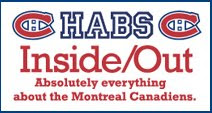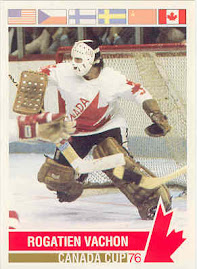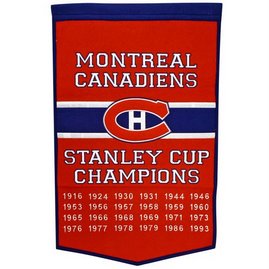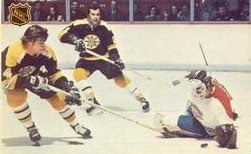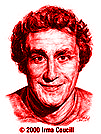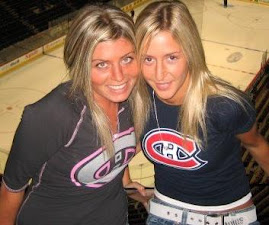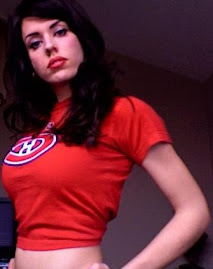
Hockey and the railways have a strong connection and have played an important part in uniting Canada. From the famous locomotive works in Stratford, Kingston and Montreal, to the railway hubs in Manitoba and the Maritimes, as well as in the numerous smaller towns that sprouted up along the tracks, many railroad workers have donned their skates to play for their local teams.
The Montreal Canadiens of 1909, and today's Les Habitants share a connection with the railway industry. During the time of the club's inception one hundred years ago, it wasn't uncommon that several of the team's players found full time or off season employment working on the rails. As train travel began connecting Canada's distant parts in the day, railway stations often had their own teams of players.
Today in Montreal, the Bell Centre sits directly against La Gare Windsor, which was originally built to serve as both the transcontinental terminal of the Canadian Pacific Railway and also as its company headquarters. Since VIA Rail consolidated its operations at Gare Centrale in the 1980s, Windsor Station has seen only commuter trains. These have been pushed far back from the station by the construction of the Bell on the site of the original trainsheds. Parts of the original station, including its surprisingly modernist skylit hall, are still maintained for public use.
So, why you might ask, am I writing about trains on a Canadiens blog?
That's a damn good question too!
Pardon the obvious bad pun, but I got sidetracked. I started out looking up the career of a former NHL player online, and links led me to learn about what this player had done for a living after retirement. As the player in question was a railway employee, it led to my discovering of how train travel and its industry tied into early Canadiens history. Some posts just happen this way, I guess.
This story get its start while my wife and I are standing in line at Metropolis in Montreal this past Grey Cup Sunday, waiting in the queue to see former Soundgarden and Audioslave lead singer Chris Cornell in concert.

Perhaps because I often wear Montreal Canadiens colours when I am out and about, I often get asked the silliest of questions, such as, "Nice hoodie, are you a fan?"
Of course I inform that yes, I am in fact a Habs empassioned nutcase with a blog, no less. It speeds up the conversation, and it helps to separate the casuals from the diehards of Habs fandom real quick.
My wife Joanne is the big fan of all things Cornell. She goes nutso in a similar compulsion as I do with the Canadiens and Springsteen. Me, I just like the Soundgarden stuff Cornell did best, and love my wife more than enough, to brave the chilling cold and make a great time of it. It wasn't difficult! My better half was more than determined to have our asses freeze off in a lineup all in the name of getting the best general admission seats in the house - which we did. Along the way, we met some equally die hard fans, and inevitably, with me in my Habs hoodie, the hockey subject came up.
After a few brief questions, one young woman whom we hung around at the backstage door with prior to the show's start and are now standing in line with informs me that her grandfather once played in the NHL.
"No way?", I ask, "With Montreal?"
"Yes, he played a season with Montreal, and then he went to New Jersey."
Now my brain is reeling, right. The young lady is at the most in her late twenties, but my guess is she can't be no more than 21 or 22. I'm calculating as I speak, while eliminating that Stephane Richer or Claude Lemieux or Rollie the Goalie can't possible have a 20 something grandchild.
I'm messed!
"What was his name?"
After a minute's struggle, she recalls the name - Maurice Croghan.
"He died before I was born. I never met him, but he played for the Maroons."
"Oh, okay, not the Canadiens then. It was the Jersey thing that threw me off. If he played for the Maroons, he could not have played for the Devils of course."
"No, I don't know who he played with in New Jersey, my family just told me he went there after playing for the Maroons in 1935."
In '35, then his name is on the Stanley Cup!", I exclaimed, to her confusion.
"I'm not sure, I'd have to ask."
I told her quickly that the name Maurice Croghan rang a bell, and that I was familiar with the history of the Maroons franchise. If indeed he played in that season, his name would be ingraved on the Cup. I told her I would look it up once I arrived home.
"Do an internet search in a couple of weeks, and you might find somthing at my site", I suggested.

The young lady, whose name I dumbly never asked for, changed the conversation flow from there, and we began talking about where we were from and what we did for a living.
She informed me that she was from the eastern townships of Quebec, in a place familiar to me - Cowansville, Quebec. I made a mental note of it, once I got into researching just who was Maurice Croghan.
As it turns out, Croghan was actually Montreal Canadiens property for a season, upon the disolution of the Maroons after the club's final 1937-38 campaign. In looking up the player, I came upon the interesting connection to the railway industry.
A brief resume of Croghan's short NHL stint reads as such: The defenseman who went by the name Moe in the day, wore number 16 and played in 16 games for the Maroons in 1937-38. Moe Croghan was termed a sturdy defensive rearguard in his day, and counted no goals or assists in his short NHL time. Upon the Maroons franchise going out of business, he became property of the Canadiens, playing in some exhibition games prior to the start of the 1938-39 season - in possibly the Habs most dismal era on record.

Croghan was born November 19, 1914 in Montreal, and played junior and senior hockey in his hometown until joining the Quebec Aces in 1936. Croghan's talent were on display that season, as the Aces ventured all the way to the Allen Cup, and after his successful run he was signed on by the Maroons.
There's no accounting of Croghan playing with a New Jersey based club around this time, but he wasn't far off in stints with the Habs affiliated Providence Reds and Springfield Indians, where he split his 1938-39 season. From 1939 to 1941, he played with the Montreal Victorias of the MCHL and the Montreal Royals of the QSHL.
After his retirement from the game, the native Montrealer relocated to Sherbrooke, Quebec, taking on a job with the Canadian National Railway as a locomotive engineer.
At age 64, Croghan passed away of a heart attack on February 7, 1979, and he is burried in Lac Brome, Quebec. In his obituary seen here, his birth name may have been "Morris" and not "Maurice", as the Lost Hockey website states a photo contribution from a Moe Croghan Jr, and this obit lists a Morris as one of his children. He was survived at the time by his wife, nee Lillian Hartley, and two daughters, Sandra Nicholson and Linda Mailloux.

That was all the detail I could find on Croghan's hockey career and life away from the game. From searching the net, I was led to site called
Hockey Railroaders, that featured a more detailed account of how some former Montreal Canadiens players made a living away from the rink.
From the early 1900's, up until World War II in the 1940's, several Canadiens players, as well as other NHLer's worked on the railroad across Canada. Aurel Joliat, Maurice Richard, Dickie Moore, Marcel Dheere, Herb Gardner, Sam Pollock, Joe Cattarinich, Lorne Chabot, Len Grosvenor, Harry Mummery, and Howie Morenz all spent a good deal of their youth and playing days learning a trade that would provide income to them once away from the rinks in summer.
During WWII, the Canadian Pacific Railway reorganized its entire shop systen for the war. Wartime shop production signaled the end of the Great Depression and offered jobs to many of its laid off CPR employees.
The Canadiens original goalie in the 1909-10 season, Jos Cattarinich, was a brakeman with CPR when he met and befriended Leo Dandurand. The pair would go on to own and manage the Canadiens for several seasons, as well as partnering in the tobacco business and horse racing endeavors.
Mummery who played for both the Canadiens and Toronto Blueshirts in 1917, was employed by the CNR as a locomotive engineer. Also working as a fireman during the season, Mummery brought his rail eating ritual to both the firehouse and the arena dressing room. A large man at 250 pounds, Mummery set up pot bellied stoves in both workplaces, cooking large steaks in them with the help of a freshly hosed shovel, a practice he took to while riding the rails and cooking his meat in the steam engine's fire box.

Morenz followed his father and uncle, apprenticing as a machinist with Stratford's Grand Trunk Railway in 1919. The Canadiens future star played for three teams in different levels in the city, one of which was operated by GTR. In one incident, Morenz had dropped a metal block on his foot, causing it to swell badly - not bad enough to cause him to miss that night's game however. After the contest, Morenz's skate boot literally needed to be cut off to remove his swollen foot from it.
Morenz was always proud of his trade, and oftenmentioned that he was a machinist by profession. Two years later, Morenz and his GTR team played a game against the Montreal CNR shops at the Mount Royal Arena. The GTR team led by Morenz steamrolled the CNR's, and Howie scored 9 goals. The performance caught the attention of the Canadiens director Cecil Hart, who then made it a point to sign Morenz.

Before his NHL career got going, goaltender Lorne Chabot worked full time with the CPR in Brandon, Manitoba while playing senior hockey with the Wheat Kings in 1921. A age 16, Chabot had enlisted in the army. Unaware of his age, he was stationed in France, driving an ammunition wagon with the Royal Canadian Field Artillery. He was soon found out and sent home.
Former Canadiens defenseman Herb Gardiner got a late start in professional hockey due to his committments to the war and the railroad. Gardiner had quit playing senior hockey at age 18 to work for the CPR as a surveyor. After serving three years with the Canadian Army, Gardiner rejoined the CPR while playing with the Calgary Tigers in the WCHL. In losing to the Canadiens in the 1924 Cup final, Gardiner made the Habs acquaintance and was signed by them two seasons later.
Len Grosvenor, who toiled with the Canadiens in 1932, worked his entire life, in and around hockey, on the railroad.

Onesime Richard, the father of Maurice, worked as a carpenter for 40 years with the CPR. Each morning he would board the train in Bordeaux and catch a ride to the Angus shop, where he would build freight cars. Maurice joined him in 1942 while playing for the Canadiens Seniors, earning up to $40 a week working as a machinest for the Munitions Department. The future Rocket was on leave a great deal at this time due to his burgeoning hockey career, and did not resign his position with CPR until after his 50 goal season.
Following his retirement from hockey in 1938, Aurel Joliat went on to work for CNR in Ottawa as an agent. He was also later employed as a coach and with the Quebec Liquor Commission.

St. Boniface's Marcel Dheere joined the Canadiens in a trade on Christmas day, 1940 and also found work at the time with Montreal RCAF and Montreal Canada Car. Dheere played hockey at several levels including the Canadiens over the next few seasons before leaving the city. He served in the military in 1944-45, and the strong connections he made while in Montreal set him up for employment with the railway as a switchman for the next 30 years.
After high school graduation in 1943, Sam Pollock was a junior clerk with the railway for a few years, while also working in hockey and baseball. He left the railway for good in 1946 to coach and scout in the Canadiens organization. Three years later, Pollock signed Dickie Moore, a CPR alumni, to a Montreal Junior Canadiens contract on the word of Frank Selke.
Hope you enjoyed this little sidetrack - it was more to do than blogging about O'Byrne derailing!
.
 I don't get it! I don't understand why a coach who has just seen his club play its best game of the season two nights earlier frigs with the mentality of his team's fragile psyche by starting his backup goalie in what could have been considered a "gimme game''.
I don't get it! I don't understand why a coach who has just seen his club play its best game of the season two nights earlier frigs with the mentality of his team's fragile psyche by starting his backup goalie in what could have been considered a "gimme game''.





















































